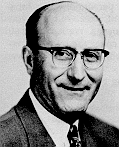Charles T. Schottland
 |
CHARLES T. SCHOTTLAND Charles T. Schottland served as Commissioner of Social Security in 1954-58. Earlier in his career, he was employed as director of the California Department of Social Welfare and as assistant to the chief of the Children's Bureau.
|
The major developments were as follows: During my administration, the major legislation was embodied in three major bills: The Social Security Amendments of 1954 (P.L. 83-761), signed September 1, 1954. The Social Security Amendments of 1956 (P.L. 84-880), signed August 1, 1956. The Social Security Amendments of 1958 (P.L. 85-840), signed August 28, 1958. 1956 Members of the uniformed services (approximately 3 million) were covered on a contributory basis. 1956 The wage base was raised again from $4,200 to $4,800. 1956 Benefits were made available to women at age 62 with an actuarial reduction for women workers and wives. 1958 Increase of 7 percent. 1956 Disability insurance benefits and benefits for disabled children above age 18 were established. 1958 Benefits for dependents were authorized. Interest rates on the OASI Trust Fund were modified in 1956 to reflect the long term character of investments. Protection for estranged wives, young widows who remarry, adopted children and certain other groups was strengthened in 1957 and 1958. Temporary hearing examiners were authorized to reduce the backlog of appeals. A new building was authorized and construction was started to house the principal activity of the Social Security Administration, namely OASI. Research and demonstration projects in Social Security were authorized in 1956. The listing above cannot convey the excitement, the controversies, and the challenges of this significant period of time in the life of Social Security. The addition of 10 million persons to the ranks of covered workers was a major step toward the goal of universal coverage, while the increase in the work load was a challenge to the administration to integrate this large number into the newly developed computer system. The excitement around the new building gave a morale boost to our staff. At last, SSA was to have its own home--a building constructed for Social Security and to its specifications. The disability freeze and the later disability insurance benefits were the result of controversial congressional hearings. Opposed by the American Medical Association, insurance companies, and others, the hearings were lively and sometimes acrimonious. None of us felt quite sure that our estimates of the numbers involved would prove to be accurate since statistical materials were not very complete and the SSA had little actual experience this field. The coverage of uniformed personnel was a satisfying consolation development since we had favored coverage of all Federal employees. We lost the battle but the Pentagon wished to cover the military personnel and in this one move 3 million persons were added to those covered. One of the most interesting battles occurred around the reduction of the retirement age for women to 62. The organized women's groups were generally opposed to this move fearing that employers would then retire women at age 62. But women generally endorsed the idea and flooded Congress with representations of support. These years were a time of growth and expansion, a time of strengthening the financing of Social Security, a time when there was a recognition that Social Security was maturing and that it was establishing a firm base of support from the overwhelming majority of our citizens. |
|